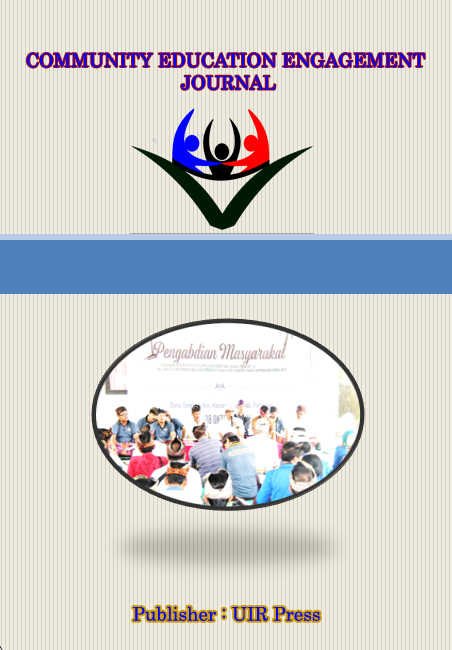4Cs’ (Critical Thinking, Communication, Collaboration, Creativity) pada Era Revolusi Industri 4.0: Pentingnya Mengenalkan Keterampilan ini Bagi Guru SMPN 1 Kuok
Keywords:
critical thinking, communication, collaboration dan creativity, SMPN 1 KuokAbstract
Pendidikan pada abad 21 ini perlu membekali siswa dengan keterampilan terutama 4Cs’ (critical thinking, communication, collaboration dan creativity). Namun, guru-guru di SMPN 1 kuok belum memahami secara utuh tentang pentingnya 4Cs’ dalam proses pembelajaran sehingga perlu dilakukan kegiatan yang bertujuan memberikan informasi tentang makna dan komponen apa saja yang terdapat pada 4C’s serta peran pentingnya dalam proses pembelajaran. Metode yang digunakan dalam kegiatan masyarakat ini berupa wawancara, presentasi dan diskusi. Kegiatan dilaksanakan pada hari Kamis, 30 September 2021 yang bertempat di SMPN 1 Kuok Kecamatan Kuok. Pemaparan materi berlangsung dengan lancar dengan dihadiri 20 orang peserta termasuk kepala sekolah. Hasil kegiatan menunjukkan bahwa guru mampu memahami dengan baik 4Cs setelah diberikan penjelasan melalui PPT. Hal ini tampak dari respon yang diberikan guru melalui jawaban-jawaban yang disampaikan melalui G-Form, Berdasarkan kegiatan ini dapat disimpulkan bahwa guru telah mampu memahami 4Cs sebagai bagian penting dari proses pembelajaran yang dibutuhkan pada era revolusi industri 4.0.
Downloads
References
Biber, A. C., Tuna, A., & Incikabi, L. (2013). An investigation of critical thinking dispositions of mathematics teacher candidates. Educational Research, 4(2), 2141–5161. http://www.interesjournals.org/ER
Bull, A., & Gilbert, J. (2012). Swimming out of our depth? Leading learning in 21st century schools. New Zealand Council for Educational Research, 1–23. http://www.nzcer.org.nz/system/files/Swimming out of our depth final.pdf
Carneiro, R., & Draxler, A. (2008). Education for the 21 st Century : lessons and challenges. European Journal of Education, 43(2), 151–172.
Flynn, B. (2014). Design-centered Learning Design-centered Learning. Carnegie Mellon University.
Greenstein, L. (2012). Assesing 21st Century Skills: A Guide to Evaluating Mastery and Authentic Learning. Sage Publication Ltd.
Janthon, U., Songkram, N., & Koraneekij, P. (2015). Work-based Blended Learning and Technological Scaffolding System to Enhance Communication Skills for Caregivers Under Local Administrative Organization, Ministry of Interior, Thailand (Part I). Procedia - Social and Behavioral Sciences, 174, 984–991. https://doi.org/10.1016/j.sbspro.2015.01.722
Krumm, G., Lemos, V., & Richaud, C. M. (2018). Personality and Creativity : A Study in. International Journal of Psychological Research, 11(1), 33–41. https://doi.org/10.21500/20112084.
Lai, E. R. (2011). Collaboration : A Literature Review Research Report. Research Reports, April, 41. http://www.datec.org.uk/CHAT/chatmeta1.htm
Martyn, J., Terwijn, R., Kek, M. Y. C. A., & Huijser, H. (2014). Exploring the relationships between teaching, approaches to learning and critical thinking in a problem-based learning foundation nursing course. Nurse Education Today, 34(5), 829–835. https://doi.org/10.1016/j.nedt.2013.04.023
Mohd Abd Wahab, A. W. A. Bin, & Shareela Binti Ismail, N. A. (2014). Communication Skills and its Impact on the Marketability of UKM Graduates. International Journal of Higher Education, 3(4), 64–71. https://doi.org/10.5430/ijhe.v3n4p64
NEA. (2012). A-Guide-to-Four-Cs.pdf. http://www.nea.org/assets/ docs/A-Guide-to-Four-Cs.pdf
Özkahraman, Ş., & Yıldırım, B. (2011). An overview of critical thinking in nursing and education. American International Journal of …, 1(2), 190–196. http://aijcrnet.com/journals/Vol_1_No_2_September_2011/25.pdf
P21. 2011. Communication and Collaboration. Retrieved from https://www.p21.org/about-us/p21-framework/261-communication-and-collaboration
Scott, C. L. (2015). What Kind of Pedagogies for the 21st Century? UNESCO Education Research and Foresight, 15, 1–21. http://repositorio.minedu.gob.pe/bitstream/handle/123456789/3747/The Futures of Learning 3 what kind of pedagogies for the 21st century.pdf?sequence=1&isAllowed=y
Thomas, I. (2011). Critical thinking, transformative learning, sustainable education, and problem-based learning in universities. Journal of Transformative Education, 7(3), 245–264. https://doi.org/10.1177/1541344610385753
Tsai, K. C. (2012). The Value of Teaching Creativity in Adult Education. International Journal of Higher Education, 1(2), 84–91. https://doi.org/10.5430/ijhe.v1n2p84
Von Colln-Appling, C., & Giuliano, D. (2017). A concept analysis of critical thinking: A guide for nurse educators. Nurse Education Today, 49, 106–109. https://doi.org/10.1016/j.nedt.2016.11.007
Waite, E., Evans, K., & Kersh, N. (2014). The challenge of establishing sustainable workplace “Skills for Life” provision in the UK: organisational “strategies” and individual “tactics.” Journal of Education and Work, 27(2), 199–219. https://doi.org/10.1080/13639080.2012.742180
Published
How to Cite
Issue
Section
Accepted 2021-10-26
Published 2021-12-20


2.png)

.png)


